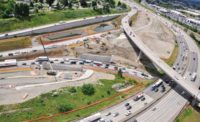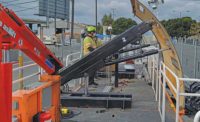Nearly 20 years into a $1.4-billion megaproject to widen and realign Interstate 5 through Tacoma, the state’s third-largest city, the Washington State Dept. of Transportation has reached one of the final stages—the $324-million I-5 Portland Avenue to Port of Tacoma Road Southbound HOV project. This phase includes 1.8 miles of interstate work and a nine-span replacement bridge on the southbound side. The bridge includes a 223-ft-long girder, the longest prestressed concrete girder in the U.S.
The project is part of WSDOT’s larger I-5 SR 16 Tacoma-Pierce County HOV program, started in 2001. It marks the last fully funded phase that completes Tacoma’s updated HOV system from I-5 to SR 16. The project is led by Guy F. Atkinson Construction, a subsidiary of Clark Construction, working with Jacobs. The design eliminates a bottleneck-inducing curve on the I-5 by replacing the existing southbound bridge over the Puyallup River with a new, wider version without a curve. That required going over both the river and an adjacent railyard used by BNSF Railway Co., the Union Pacific Railroad and Tacoma Rail. The design also removes piers from the river, which required the work to “stretch the girders out as far as possible,” says Jay Teskey, Atkinson’s senior construction manager.
And with 84 girders in the 1,579-ft-long, 73-ft-wide Puyallup River Bridge, Atkinson needed a mix of girder sizes in spans four through nine and in spans one through three. Span two is where the 223-ft-long girder comes in, just one of 11 girders in that span with an average length of 215 ft, ranging from 207 ft long to the single 223-ft girder.
“We elected to stretch the girder as far as the engineering would allow us to do so,” says Teskey.
“We elected to stretch the girder as far as the engineering would allow us to do so.”
– Jay Teskey, Construction Manager, Guy F. Atkinson Construction
The larger program, with 14 completed projects, stems from WSDOT’s early-1990s HOV system on state highways around greater Seattle that expanded HOV lanes for 320 miles, mostly north of Tacoma. The recently completed northbound section is located next to the current work zone, meaning Atkinson is building the southbound replacement bridge within 8 ft of the new northbound bridge. Cara Mitchell, WSDOT project spokeswoman, says the final result creates a straighter horizontal and vertical curve to provide drivers with better sight distances. The project also adds a new northbound I-5 auxiliary lane between I-705 and Portland Avenue.
“Once complete, there will be HOV connectivity on SR 16 from Gig Harbor all the way to I-5 through Tacoma and north into King County,” Mitchell says. “It is something this program has been working toward for a very long time. We know travelers will be relieved when construction is finished.”
The new girder, created by Tacoma’s Concrete Technology Corp., sits ready for transport for a mid-November installation. Jim Parkins, Concrete Technology spokesman, says finding the right concrete mix was challenging because of limitations on the hauling weight. The team ultimately settled on lightweight coarse aggregate in the mix, which reduced density by 14% “to maintain the girder weight within the capacity of existing transportation equipment,” Parkins says.
The largest girder weighs nearly 247,000 lb and will be the longest single-piece pretensioned concrete girder shipped by truck in the Western Hemisphere, says Parkins. Within the girder, 91 strands were pretensioned to a total force of more than 4 million lb, including a camber of approximately 8 in.
Spans four through nine of the bridge are in place, with four decks already positioned. Crews, delayed by a WSDOT-mandated 35-day work stoppage during spring because of COVID-19, are finishing the substructure of caps and columns to receive the large girders for span two. Work on spans one and three will follow the larger girder placement.
Atkinson’s Teskey says the first challenge will be to load and transport the girder to the project site. Local trucking company V. Van Dyke is working to route the girder into the staging location on the existing southbound I-5 Puyallup River Bridge. From there, it will take two 300-ton 2250 Manitowoc crawler cranes to lift the girder into place. Each crane requires 11 truckloads of pieces to assemble it. Working between the river, the railroad and Highway 167, Teskey says the work zones are tight. “We’ve put a lot of ingenuity and thought in how to assemble the cranes and get them in position,” he says.
One of the cranes will rest on the river levy, which was raised 6 ft and reinforced with sheets to handle the crane. With the likelihood of rain in mid-November, weather could be a factor. “Our crews are well seasoned and experienced working in the rain,” Teskey says.
While the rigging points and connections on the girder are standard, Teskey says crews will need to pick the girder from behind, then pass it through the cranes to get it into position. Crews partially demolished an I-5 bridge to create more room for the cranes. The five-hour installation window will require a full shutdown of Highway 167.
“Once complete, there will be HOV connectivity on SR 16 from Gig Harbor all the way to I-5 through Tacoma and north into King County.”
– Cara Mitchell, WSDOT
The railroads typically don’t allow activity over their tracks from October through January, the busiest time for the shipping season, but the construction team worked with them to create a flagged area and avoid a full track closure. The railroads can force construction to stop if a train needs to pass.
“Additional coordination is needed for work around the active railroads that run underneath the new bridge,” Mitchell says. “This coordination is something unique to this project, and we know it has to be successful in order for the project to be successful.”
The project also includes a 1,100-ft soil-nail wall that required four rows of nails driven into the hillside and then mixed sprayed-on concrete and concrete panels to secure the hillside—all to create space for the northbound auxiliary lane.
Along with the Puyallup River Bridge, Atkinson is working on a three-span L Street bridge, currently being completed. It is elevated 50 ft over I-5 with a 10% downslope, “a tricky bridge to build,” Teskey says, along with modifications on two other bridges. One of the bridges required complete demolition.
Another key portion of the project replaces the pavement along the entire 1.8-mile stretch, a mix of nearly 19,000 cu yd of Portland cement concrete pavement and more than 75,000 tons of hot-mix asphalt. The combination, along with bridge decking 4000D high-performance concrete mix, required more complex staging.
With the trickiest girder placements planned in November, Teskey says COVID restrictions added a “little hiccup in the whole plan,” but the team has regained traction and is back on schedule. Substantial completion is set for September 2022.











Post a comment to this article
Report Abusive Comment